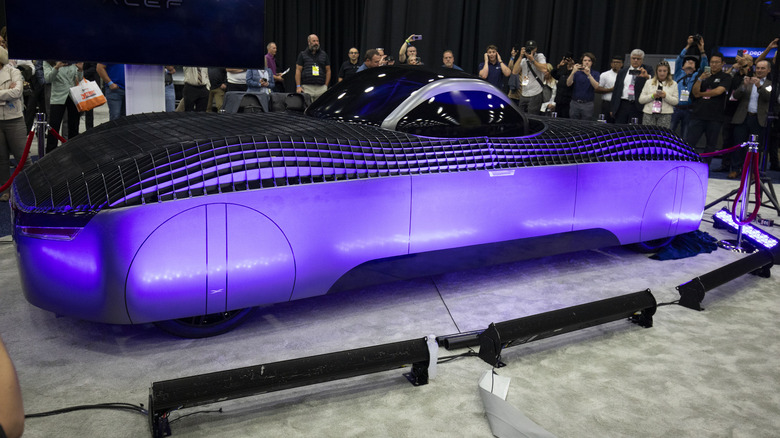Here Is What's Stopping Flying Cars And Jetpacks From Going Mainstream
Creators of science fiction love to put their imaginations on display with visions of futuristic technology, but the trouble with predicting the future is that one day, reality will put you to the test. There are no better examples of this than flying cars and jetpacks, the most iconic forms of sci-fi transportation. According to some of the movies that made these technologies famous, we ought to have them by now. "Blade Runner" was set in the year 2019, yet the flying "Spinner" car that Rick Deckard patrols in is nowhere to be seen. "The Running Man" supposedly took place in 2017, but you don't see the people flying around with one of the jetpacks that its hero, Ben Richards, has access to. These predictions weren't entirely off the mark though, as flying cars and jetpacks both, in fact, exist. The reason they haven't gone mainstream yet is that they're a logistical nightmare.
Compared to other science fiction-inspired technologies like holograms and video calls, jetpacks and flying cars pose higher costs, more safety concerns, and greater regulatory obstacles. But still, the biggest technical issue is power. Currently, nearly every airborne transport relies on jet fuel, which is not accessible on a mainstream scale, and contributes more to the greenhouse gas effect than the gasoline used in cars. However, a growing collection of companies around the world is slowly pushing us closer to a world where these concerns are eliminated, and we might finally zip to work through the air like the Jetsons.
How far are we from mainstream flying cars?
Creating flying cars might sound as basic as making airplanes smaller, but there is a crucial difference between today's commercial jets and the flying cars imagined in sci-fi that must be addressed first. Planes require a long runway in order to accelerate for takeoff and decelerate for landing. A regular home driveway can't afford that space, so if flying cars are to ever go mainstream, they need to be able to take off and land without any buildup. There's a term for such vehicles — vertical takeoff and landing (VTOL) aircraft — and the best example today is the helicopter. So why don't we just use helicopter technology to make flying cars? Well, just imagine a world where rush hour traffic comes with the chopping sound of thousands of helicopter blades.
To effectively go mainstream, flying cars need to be compact, quiet, and fuel efficient. That's where EVTOLs (electric vertical takeoff and landing aircraft) come into play. By making fully-electric personal aircraft, companies are hoping to address the problems of power efficiency and noise at once. Currently, two Silicon Valley products, the Alef Flying Car (which may very soon enter production) and Jetson One (touted as the first real flying car) are purportedly ramping up to mass production, but they'll have to contend with a host of other obstacles. With six-figure price tags, these vehicles are hardly affordable to the public. More problematically, introducing flying cars will require a complete rethinking of transportation infrastructure, massively more complex air control, and training the public to master a far more difficult type of driving.
How far are we from mainstream jetpacks?
Jetpacks are a technology that we've had one foot in and one foot out of for decades. Astronauts have been using a form of backpack propulsion since 1984, called a manned maneuvering unit, that allows them to propel themselves on spacewalks. There are also hydro jetpacks, which use powerful blasts of water to lift the wearer up. However, hydro jetpacks can only be used over water, limiting their mainstream potential, and, of course, astronauts' manned maneuvering units aren't very useful outside of microgravity. As far as jetpacks that everyday commuters could use, several major obstacles need to be addressed before mass production could be possible. As with flying cars, introducing jetpacks to the mainstream would require a complete rethinking of infrastructure with massive health and safety risks at play, but with jetpacks, the technical issues are even greater.
A jetpack needs to be light enough to wear, but generating enough power for sustained flight requires a large, and therefore heavy, battery. Portability comes at the cost of power. A California-based company, JetPack Aviation, made waves in 2015 when its CEO flew around the Statue of Liberty with a jetpack, but he was limited to just around 10 minutes in the air. At present, jetpack technology still labors in this realm of novelty, unable to balance the needs of power and portability. Jetpacks also lag behind flying cars for another reason: The human body just isn't very aerodynamic, and there's nothing much we can do about that.


